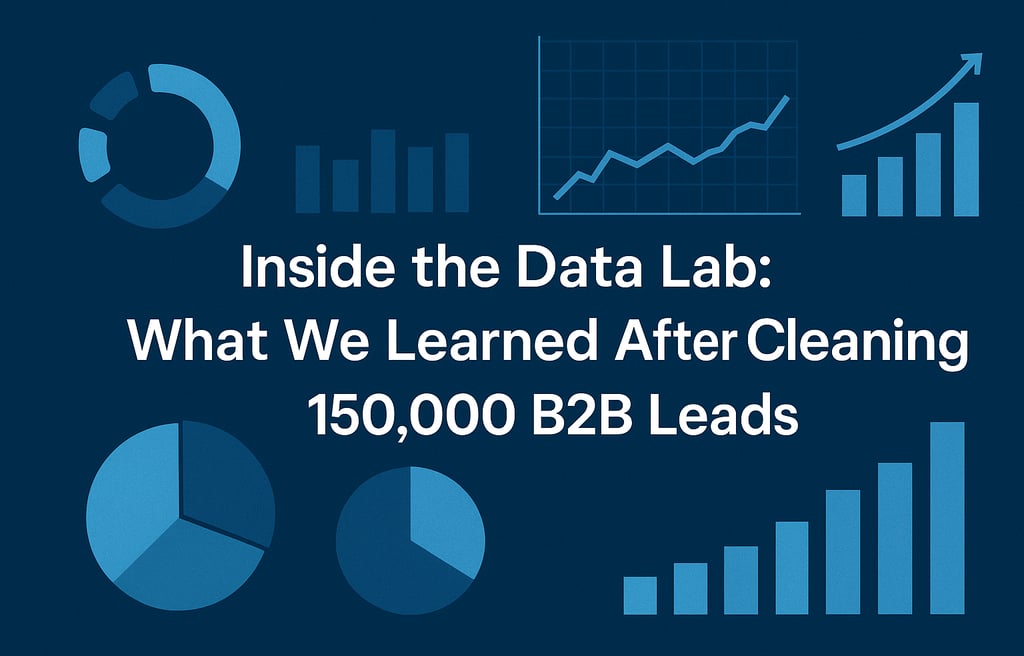Inside the Data Lab: Lessons From Cleaning 150,000 B2B Leads (and Counting)
A behind-the-scenes look at what really happens when you clean 150,000 B2B leads — the shocking patterns, validation fails, and insights that shaped how we built CapLeads’ verified database.
SALES & GROWTHB2B MARKETINGDATA VALIDATION & ACCURACYCOLD CAMPAIGNS
A. Sanchez
10/18/20252 min read


Inside the Data Lab: Lessons From Cleaning 150,000 B2B Leads (and Counting)
When we started building CapLeads, we thought data cleaning would be the easy part — upload, filter, validate, done. But after scrubbing through 150,000 B2B leads across dozens of industries, we realized how wrong we were. What looked like a few spreadsheets quickly turned into a crash course on how messy business data really is.
1. Over 30% of leads fail the first validation
The first shock came when we ran our initial batch through NeverBounce. Out of every 10,000 emails, roughly 3,000 were either invalid, disposable, or catch-all domains. Some were so obviously fake it almost felt intentional — like “ceo@noemail.com” or “test123@company.co.” These weren’t small-time lists either. Many came from well-known “premium” data providers that claim 95% accuracy.
It made one thing very clear: most B2B contact lists online are built for volume, not performance.
2. Titles lie — a lot
One of the strangest patterns we found was how inflated job titles have become. We’d see “Director of Strategy” working at a two-person agency, or “CFO” for a freelance consultant. It doesn’t always mean the contact is useless, but it changes how your outreach should sound. Cleaning isn’t just about removing bad emails — it’s about removing bad assumptions.
3. Duplicates hide everywhere
We thought duplicates would be easy to spot. They’re not. A single company might show up under 5 different variations — “Acme Inc.”, “Acme Incorporated”, “ACME Pty Ltd”, and even “ACME (HQ)”. After refining our match rules, we learned that true de-duplication takes pattern recognition, not just exact matches.
4. Industry tags are often wrong
A company selling accounting software was tagged under “Financial Services,” while a marketing automation startup was labeled “Retail.” This mistake can destroy cold campaigns — you might think you’re reaching decision-makers in FinTech, but you’re actually hitting restaurant suppliers. We had to rebuild entire industry maps by hand to make sure targeting was clean.
5. The 2% that make it worth it
After all the cleaning, validations, and cross-checks, we ended up with a dataset we could finally trust. Open rates jumped, bounce rates dropped below 1%, and replies started sounding like real conversations again. It proved that quality beats quantity — every single time.
The Takeaway
Behind every “verified” lead list, there’s a data lab full of invisible work — validation, deduplication, enrichment, and correction. That’s the real engine of CapLeads. Every industry pack we offer has gone through this same process, because if the data’s bad, no campaign can fix it.
If you’re done wasting time on junk data, explore our verified B2B lead packs — cleaned, tested, and ready to send.
Related Posts
FinTech B2B Leads in 2025: Verified, Updated, and Ready for Outreach
Why Email Bounces Kill Your Cold Campaigns (and How to Prevent Them)
Why Startups Struggle to Find Quality Leads (and How to Finally Fix It
SaaS: The Hidden Growth Multiplier for Founders Using Verified Outreach Lists
The New Era of Smart B2B Prospecting
Cheap Leads Cost More: How Junk Data Destroys Early-Stage Growth
Inside the Data Lab: Lessons From Cleaning 150,000 B2B Leads (and Counting)
We Validated 30,000 B2B Leads — 30% Were Fake. Here’s What We Found.
Connect
Get verified leads that drive real results for your business today.
www.capleads.org
© 2025. All rights reserved.
Serving clients worldwide.
CapLeads provides verified B2B datasets with accurate contacts and direct phone numbers. Our data helps startups and sales teams reach C-level executives in FinTech, SaaS, Consulting, and other industries.
